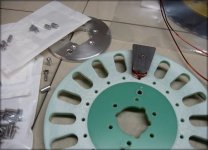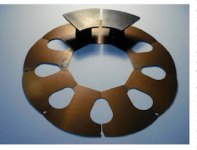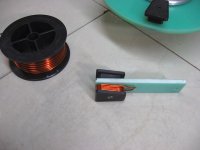Moving on. I had hoped to be a bit farther along by now, but a few problems are setting me back. I found out that
this fiberglass board isn't exactly the same thickness throughout. Plus, I designed the core slots in back about a 1/2 mm
to short, and the cores don't quite come together in the middle.
So I chucked the carrier in the lathe, and turned about .015" off the two sides. Using a little plasti-guage I was able to
confirm that they are connecting in the middle. I also drilled some holes for the wire to pass through from side to side.
I know that one wire will pass over the top, between the coils, and another will go through the hole, but other than that,
I'll have to wait and see how it goes. I also finished milling the slots a little longer to accommodate the longer cores.

I had to send off for some tooling that I need to finish putting the standoffs in the cores, so I can bolt them together,
I'm still waiting for that. Meanwhile, I'm trying to figure out exactly how to wind the coils, and get them on the cores.
I'd rather not wind them directly on the cores, because the SMC is so sensitive, and there's a lot of force involved in
manipulating 14 ga wire into shape. But it might come to that anyway.
I can print up some plastic cores to wind the wire on, but then I need to get it back off, and on to the steel cores without
distorting, which would require some kind of glue.
I can also design and print some bobbins to hold the wire, but they would have to be really thin, as I'm not sure there's
any room for them in there as things are. How thin can a print be made?





